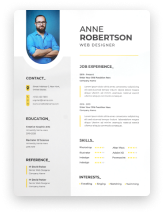In this comprehensive guide, we will delve into the art and science of crafting a winning resume in 2024. Your resume is your gateway to the competitive job market, and it's no longer just a list of qualifications; it's a strategic tool that can set you apart from the crowd. With the evolving dynamics of employment and the prevalence of digital hiring processes, knowing how to create a standout resume is more critical than ever.
This guide is your go-to resource for understanding the nuances of resume writing, optimizing your resume for Applicant Tracking Systems (ATS), and tailoring it to impress hiring managers in various industries. Whether you're a recent graduate, a seasoned professional, or someone seeking a career change, we'll provide expert insights, tips, and strategies to help you craft a resume that not only tells your professional story but also makes it impossible for employers to overlook your unique qualifications.

Objectives of the Guide
This comprehensive guide aims to equip you with the tools, knowledge, and strategies to create a resume that not only highlights your professional journey but also aligns with the demands and trends of the 2024 job market. Whether you're a fresh graduate, a mid-level professional, or looking to make a career change, this guide is your roadmap to crafting a resume that opens doors.
Understanding the basics of resume crafting is vital. In the next sections, we'll dive deep into distinguishing between a resume and a CV, understanding the digital evolution of resumes, and laying the groundwork for writing a resume that stands out.
Understanding the Basics
Resume vs. CV: Clearing the Confusion
At first glance, resumes and CVs (Curriculum Vitae) may seem interchangeable, but they serve distinct purposes. A resume is a concise, one-to-two-page summary of your skills, experience, and education tailored to a specific job. In contrast, a CV is a more detailed and lengthy document, often used in academic, medical, or scientific fields, highlighting your entire career path.
The Evolution of Resumes in the Digital Era
The digital era has revolutionized how resumes are created, shared, and reviewed. In 2024, online presence and social media profiles complement traditional resumes, offering a holistic view of a candidate's professional persona. ATS software has become a norm in screening resumes, making it imperative to optimize your resume with relevant keywords and a format that is ATS-friendly.
Preparing to write your resume involves a strategic approach, where understanding the job description and identifying your unique value proposition become key steps. In the following sections, we'll explore how to analyze job descriptions for keywords and how to articulate your unique value proposition effectively.
Preparing to Write Your Resume
Analyzing Job Descriptions for Keywords
Before you start writing your resume, it's crucial to understand the job you're applying for. Scrutinize the job ad to identify keywords and phrases that describe the desired skills, experiences, and qualifications. These keywords are essential, as they are often what HR managers and ATS software look for in a candidate's resume.
For instance, if the job ad emphasizes "project management," "team leadership," and "agile methodology," ensure these terms prominently feature in your resume, provided they align with your experience.
Identifying Your Unique Value Proposition
Every job-seeker brings a unique blend of skills, experiences, and personality traits to the table. Your unique value proposition (UVP) is what sets you apart from other candidates. To identify your UVP, ask yourself:
-
What unique skills or experiences do I possess that are relevant to the job?
-
How have I contributed to previous roles in a way that had a significant impact?
-
What are my professional accomplishments that align with the needs of the potential employer?
Reflecting on these questions helps in crafting a resume that not only lists your experiences but also showcases your unique contributions and the value you bring.
Next, we will delve into the structure of a modern resume, covering essential components from contact information to the skills section. Each part plays a critical role in presenting a cohesive and compelling narrative of your professional journey.
Structure of a Modern Resume
Contact Information: Essentials and Etiquette
Your contact information is your first handshake with the employer. It should include:
-
Name: Clearly state your full name at the top.
-
Phone Number: Provide a reliable number.
-
Email Address: Use a professional email.
-
Location: City and state suffice. Full address is not necessary.
-
LinkedIn Profile: If relevant, include the URL.
-
Professional Title: Optional, but it can reinforce your job target.
Correct Example:
Jane Doe - Marketing Manager
555-123-4567 | janedoe@email.com
Incorrect Example:
Jane - Marketing Guru
555-123-4567, janedoe@email.com
Professional Summary: Making a Strong First Impression
The professional summary is a brief statement at the top of your resume. It should encapsulate your key qualifications, career goals, and what you bring to the table. This is not just a list of skills but a compelling introduction that aligns with the job you're targeting.
"Experienced marketing manager with over five years in developing successful campaigns for consumer goods. Proven track record in leading effective teams to achieve sales targets. Seeking to leverage my expertise to contribute to XYZ Company's growth."
Work Experience: Framing Your Career Story
Your work experience section should detail your previous roles, focusing on achievements rather than just responsibilities. Use action verbs and quantify your accomplishments where possible.
-
Start with your most recent job.
-
List your job title, company name, and dates of employment.
-
Bullet points should highlight key accomplishments and skills.
"Led a team of 10 sales associates to exceed sales targets by 15% in Q4 2021, resulting in a significant profit increase for the company."
Education Section: Highlighting Academic Achievements
Include your highest level of education, the name of the institution, and the year of graduation. If you're a recent graduate, you can mention relevant coursework, honors, or GPA (if impressive).
Skills Section: Tailoring to the Job Market
List skills that are directly relevant to the job. This can include both hard skills (like specific software proficiency) and soft skills (like communication or problem-solving).
Advanced resume crafting techniques like quantifying achievements and highlighting certifications will be covered in the next sections. These elements are key to creating a resume that doesn't just list your experiences but demonstrates your impact and qualifications.
Advanced Resume Crafting
Achievements and Metrics: Quantifying Success
Incorporating specific achievements and metrics in your resume can significantly elevate its impact. Quantifying your successes provides concrete evidence of your capabilities and contributions. For example:
-
Instead of saying "Managed a team," say "Managed a team of 15 members, increasing productivity by 20%."
-
Rather than "Increased sales," specify "Increased sales by 35% over six months through strategic marketing campaigns."
Certifications and Additional Training
Highlight any relevant certifications or additional training you've completed that enhance your qualifications for the job. This could include:
-
Professional certifications relevant to your industry.
-
Workshops, seminars, or courses that have contributed to your skillset.
"Certified Project Management Professional (PMP) with extensive experience in Agile methodologies and team leadership."
Volunteer Work and Extracurriculars: The Untapped Potential
Don't overlook volunteer work and extracurricular activities, especially if they demonstrate skills relevant to the job. This is particularly valuable for new graduates or those with limited work experience.
-
Include leadership roles in community service or organizations.
-
Highlight specific projects or initiatives you led or contributed to significantly.
Language and Technical Proficiencies
In today's global job market, language skills can be a significant advantage. List any additional languages you speak and your proficiency level. Similarly, highlight technical skills, especially those that are in high demand in your industry.
Design and aesthetics play a crucial role in how your resume is perceived. The next sections will guide you through choosing the right resume format, ensuring visual appeal, and balancing creativity with professionalism.
Design and Aesthetics
Choosing the Right Resume Format
The format of your resume should align with your career story and the job you're applying for. There are three main formats:
-
Chronological: Focuses on work history, ideal for those with a solid and continuous work record.
-
Functional: Emphasizes skills and experiences, suitable for career changers or those with gaps in employment.
-
Combination: Blends both chronological and functional elements, great for showcasing both skills and experience.
Visual Appeal: Fonts, Colors, and Layout
The visual appeal of your resume makes a significant first impression. Here are some tips:
-
Fonts: Use professional and readable fonts like Arial, Calibri, or Times New Roman.
-
Colors: Stick to a simple color scheme. If you use colors, ensure they are subtle and professional.
-
Layout: Ensure enough white space for readability. Keep margins even and use bullet points for lists.
Balancing Creativity and Professionalism
While it's important to stand out, it's crucial to maintain professionalism:
-
Creative industries may allow for more design freedom, while corporate roles might prefer traditional formats.
-
Avoid over-the-top graphics or elements that might detract from the content.
Navigating resume writing challenges can be daunting, especially when dealing with career gaps, job hopping, or a lack of experience. The upcoming sections will provide strategies to handle these challenges effectively, ensuring your resume remains strong and compelling.
Navigating Resume Writing Challenges
Career Gaps and Job Hopping: Strategic Explanations
Career gaps and frequent job changes can raise questions for potential employers. However, these can be addressed strategically:
-
Career Gaps: Be honest about gaps, whether they were for personal reasons, education, or skill development. Briefly explain in the cover letter or interview.
-
Job Hopping: Emphasize the diverse skills and experiences gained. Focus on achievements and learning from each role.
Correct Example:
"Took a career break for professional development and certification in digital marketing."
New Graduates: Building a Resume with Limited Experience
For new graduates, the challenge is to demonstrate potential:
-
Highlight academic achievements, relevant coursework, and projects.
-
Include internships, volunteer work, and extracurricular activities that showcase relevant skills.
Career Changers: Transferring Skills Across Industries
Career changers should focus on transferable skills:
-
Identify skills from your previous career that are relevant to the new role.
-
Use a functional or combination resume format to emphasize these skills over specific job roles.
Leveraging technology in resume writing is key in the digital era. The following sections will cover the use of resume building tools, optimizing for ATS, and ensuring your resume is up-to-date with the latest trends.
Leveraging Technology
Using Resume Building Tools and Software
In 2024, numerous tools and software can simplify the resume-building process. These tools offer:
-
Templates that provide structure and design options.
-
Customization features to tailor your resume for different job applications.
-
Suggestions for phrasing and keywords.
Optimizing for Applicant Tracking Systems (ATS)
ATS software is widely used by companies to screen resumes. To optimize your resume for ATS:
-
Use standard headings like 'Work Experience' and 'Education'.
-
Include keywords from the job description.
-
Avoid graphics or tables that might confuse the ATS.
Final touches on your resume are crucial. The next sections will delve into the importance of proofreading, getting feedback, and the appropriate submission and follow-up techniques to ensure your resume makes the best possible impression.
Final Touches
Proofreading: Avoiding Common Mistakes
Proofreading is a critical step in the resume-writing process. It's not just about checking for typos but also ensuring clarity and consistency. Here are some tips:
-
Check for grammar and spelling errors.
-
Ensure consistent tense, formatting, and font usage.
-
Verify all contact details and dates are correct.
Getting Feedback: Why Peer Review Matters
Getting a second opinion on your resume can provide valuable insights. Feedback can help identify areas for improvement that you might have overlooked. Consider asking mentors, colleagues, or professional resume reviewers for their input.
Submission and Follow-Up
After tailoring your resume for a specific job application:
-
Submit it in the requested format (often PDF or Word).
-
Follow the application instructions precisely.
-
After submission, a polite follow-up email can express your continued interest and keep you on the employer's radar.
Tailoring your resume for different job applications and the role of cover letters will be covered in the next section. These are key strategies to enhance the effectiveness of your job application process.
Submission and Follow-Up
Tailoring Your Resume for Different Job Applications
Each job application is unique, and so should be your resume. Tailoring your resume involves:
-
Adapting the summary and skills sections to align with the specific job description.
-
Highlighting experiences and achievements most relevant to the position.
-
Using keywords from the job ad to enhance ATS compatibility.
Cover Letters: Complementing Your Resume
A cover letter is a vital complement to your resume. It offers an opportunity to:
-
Elaborate on your qualifications and experiences.
-
Explain how your skills make you a good fit for the role.
-
Show enthusiasm for the position and the company.
Tracking Your Applications and Following Up
Staying organized during your job search is crucial. Keep a record of:
-
Where and when you applied.
-
Customized resumes and cover letters sent.
-
Responses received and follow-up actions.
Following up with a polite email or call can demonstrate your interest and initiative. However, respect the employer's process and avoid overly frequent or aggressive follow-ups.
The conclusion will recap the key takeaways for creating a winning resume and preparing for the next steps in your career journey, including interviews and networking.

Conclusion
Recap: Key Takeaways for a Winning Resume
Crafting a winning resume in 2024 involves understanding the nuances of the modern job market and leveraging them to your advantage. Remember:
-
Tailor your resume to each job application with relevant keywords and experiences.
-
Keep your layout clean, professional, and ATS-friendly.
-
Highlight your unique value proposition through your achievements and skills.
-
Proofread meticulously and seek feedback to refine your resume.
Preparing for Next Steps: Interviews and Networking
With a strong resume in hand, the next steps are preparing for interviews and networking:
-
Research common interview questions and practice your responses.
-
Develop a compelling personal pitch that summarizes your professional background and aspirations.
-
Leverage social media and professional platforms like LinkedIn for networking and staying informed about industry trends.
FAQs
Q1. How Often Should I Update My Resume?
A: Update your resume regularly, especially when you gain new skills, complete significant projects, or change roles.
Q2. Can a Resume Be More Than One Page?
A: For most professionals, especially those early in their careers, a one-page resume is ideal. More experienced candidates can extend to two pages if necessary.
Q3. How to Address Employment Gaps?
A: Be honest about employment gaps, focusing on any constructive activities during the period, such as volunteering, studying, or freelance work.
Q4. Should I Include Hobbies and Interests?
A: Include hobbies and interests if they are relevant to the job or demonstrate transferable skills.
Recommended Reading






